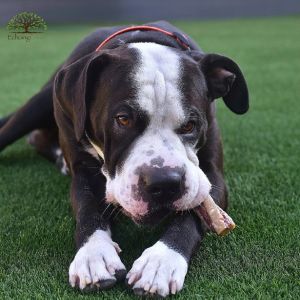18 Oct 2024
Avoid Drainage Problems with Artificial Grass Installation
Artificial grass installations have increased in recent years among those who want an even lower maintenance alternative to having a natural lawn. From upgrading aesthetics and saving water to pet-friendly surfaces, the uses of artificial grass have become increasingly diverse. However, perhaps the most important consideration with artificial grass, which is overlooked by many, is drainage. Proper drainage will keep your artificial grass functional, odour-free, and comfortable for you and your pets, especially in homes with dogs. In this article, we'll touch on how to avoid drainage issues and how artificial grass for dogs acts as a superior alternative for those with pets. If you're looking into professional installation services, Trust Echoing Green today to get started with your project.
Why Artificial Grass Installation Requires Draining
 Drainage in your artificial grass installation is highly critical and plays an important role in maintaining longevity and functionality. In the event of poor drainage, water may actually accumulate on the surface, creating a list of problems that include mold growth, foul odours, and water damage to the base layer. These, over time, will degrade the quality of the artificial grass, making it less attractive and durable.
Drainage in your artificial grass installation is highly critical and plays an important role in maintaining longevity and functionality. In the event of poor drainage, water may actually accumulate on the surface, creating a list of problems that include mold growth, foul odours, and water damage to the base layer. These, over time, will degrade the quality of the artificial grass, making it less attractive and durable.
The bigger problem is the water retention in your yard when heavy rains occur. An efficient draining system lets the water pass through the grass and soak into the ground rather than stagnate on the surface of the lawn. In addition to keeping the lawn dry and accessible throughout the year, stagnation of water causes lawn damage and increases maintenance efforts. This can be avoided by installing appropriate drainage solutions alongside artificial grass.
Key Features of Artificial Grass for Dogs
Artificial grass for dogs should be installed in your yard for several reasons, for a lot of pet owners, more so those with dogs. Arguably, the main benefits that come with artificial grass for dogs pertain to their design; with better drainage capabilities than ever, it's fully equipped to dispose of both pet waste and water with efficiency.
Most pet-friendly artificial grass varieties come with built-in drainage holes so that urine and other liquids can pass easily without accumulating on the surface. This greatly helps to keep the grass clean and reduces the chances of unpleasant odours. Speaking from a dog owner's perspective, this is priceless, for it means your pet's area of play can remain hygienically clean and fresh, even when a lot of activity takes place.
In addition to improved drainage, artificial grass for dogs is often far more resilient, with improved wear and tear resistance. That means your dog can dig or play vigorously, yet the grass will remain intact and look great for many years.
How to Ensure Proper Drainage with Artificial Grass Installation
Good drainage whenever you are installing artificial grass is very important to avoid any potential water problems that might arise in later stages. Appropriately preparing the ground to lay the grass in a proper way should be an effective way of ensuring appropriate drainage. Secondly, one has to make sure the area is level and graded so that water can naturally flow away from a house or any other structure.
The other critical point in the installation of artificial grass has to do with the base itself. A good base, usually prepared with material like crushed stones or gravel on the ground, needs to be pervious to water so as to allow water to get through it easily. This type of base layer plays a significant role in keeping artificial grass dry and prevents the pooling of water if there is any at the surface.
Tips to Maintain Artificial Grass to Avoid Drainage Issues
Perhaps the most important thing related to the prevention of drainage problems in the long run is maintaining your artificial grass. Among the easy ways to maintain the grass is simply cleaning the surface from debris, leaves, and dirt. These materials block the drainage holes, which results in built-up water on the surface.
More importantly, regular brushing keeps the fibres of artificial grass from compacting, a factor that really hinders drainage. In time, heavy foot traffic and pet activity can make fibres lay flat, reducing their ability to allow water to pass through, so ensure you are brushing when needed.
Finally, it is advisable to check the foundation layer periodically so that this layer stays permeable. If you happen to see the effects of drainage problems, like water accumulation or the slowing down of absorption, then it is probably time to call a professional who can evaluate the situation and make any necessary modifications.
Avoid Drainage Issues with Your Artificial Grass for Pets
The incorporation of an appropriate drainage system plays an important role in ensuring functionality and aesthetic appeal for your artificial grass installation. For pet owners, artificial grass for dogs offers even greater advantages by promoting cleanliness and odour control through effective drainage. Whether you're upgrading your yard for aesthetic purposes or creating a comfortable environment for your pets, investing in a quality installation can help you avoid many common drainage problems. If you need a perfect and durable installation, feel free to contact Echoing Green for professional advice and service.
Call Now!

